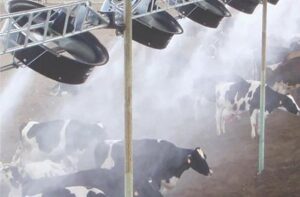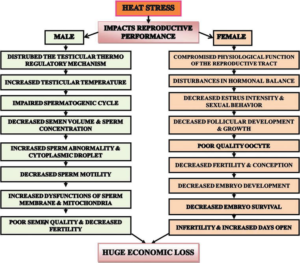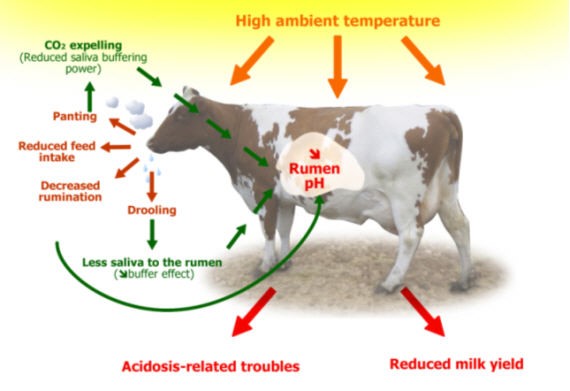Heat Stress in Animals: Management Strategies and Treatment Approaches
Deshmukh Kaivalya Ruprao1, Rele Gauri Shrikant2
1M.V.Sc Scholar, Division Of Biochemistry, Indian Veterinary Research Institute ,Izatnagar.
2M.V.Sc Scholar, Division Of Physiology And Climatology, Indian Veterinary Research Institute, Izatnagar
What is Heat Stress? When an animal is exposed to temperatures that are too high for it to efficiently regulate its body temperature, it might develop a physiological condition known as heat stress. This disease develops when an animal’s capacity to release heat is inadequate to sustain thermal equilibrium. This is mostly due to processes including radiation, evaporation, convection, and conduction. Animal health, welfare, and production can be negatively impacted by heat stress in a number of ways, including dehydration, heat exhaustion, heat stroke, decreased feed intake, slower growth rates, poor reproductive outcomes, and increased disease susceptibility.
Economical empact:
- Livestock Productivity: Heat stress lowers dairy cow milk output, beef cattle growth rates, and poultry egg production, which means less money for producers.
2. Animal Health Costs: Heat stress affects profitability and production efficiency by raising veterinarian costs for heat-related diseases and problems.
3. Reproductive Efficiency: Heat stress raises breeding costs and decreases overall reproductive efficiency by decreasing conception rates and lengthening calving intervals.
4. Mortality and Morbidity: High temperatures cause animals to die more frequently, which costs livestock farmers and pet owners more money in losses and veterinary care. 5. Feed and Water Costs: Animals under stress from heat may drink less water and consume less feed overall, which raises production costs.

6.Heat Mitigation Measures: While investing in cooling, ventilation, and shade systems raises production costs, they also reduce economic losses and heat stress.
7. Market Impacts: Reductions in livestock quality and productivity brought on by heat stress may have an impact on market pricing and supply chain competitiveness.

Susceptible animals:
Holstein-Friesian (Cattle): Large size, dense black and white coat, and high metabolic rate make them highly susceptible to heat stress, especially in hot and humid climates.
- Moderate Susceptibility:
Hereford (Cattle): While more heat-tolerant than dairy breeds, they can still experience heat stress, particularly without access to shade and ventilation.
- Low Susceptibility:
Brahman (Cattle): Well-adapted to hot climates with loose skin, hump, and large ears aiding heat dissipation.
Sahiwal (Cattle): Originating from tropical regions, they have a reddish-brown coat, reflecting sunlight, and exhibit good heat tolerance.
Water Buffalo: Generally more heat-tolerant than cattle, with wide ears and a preference for wallowing in water to cool off.
When does it get the most stressful?
| Part of India | Comfortable months | Stressful months |
| Northern Part | November-February | May-September |
| Western Part | December-January | May-September |
| Southern Part | November-February | April-September |
| Eastern Part | November-February | April-October |
Detection of heat stress in animal :
- Behavioral Signs:
– Increased panting or open-mouth breathing.
– Restlessness, agitation, or seeking shade.
– Reduced activity or reluctance to move.
– Aggression or irritability, especially in groups.
- Physical Signs:
– Elevated body temperature (normal ranges vary by species).
– Excessive salivation or drooling.
– Rapid pulse and heart rate.
– Dry, hot skin or sweating (in species capable of sweating).
– Weakness, staggering, or collapse.
- Environmental Conditions:
– High ambient temperatures, especially when combined with high humidity.
– Lack of shade or shelter from direct sunlight.
– Poor ventilation or air movement in housing facilities.
- Diagnostic Tests:
– Measuring rectal temperature using a thermometer.
– Monitoring heart rate and respiratory rate.
– Assessing hydration status (e.g., skin turgor, capillary refill time).
– Blood tests to evaluate electrolyte levels, acid-base balance, and markers of dehydration or heat stress-related complications.
- Veterinary Examination:
-Veterinary professionals may conduct a thorough physical examination to assess the animal’s overall health and identify any indicators of heat stress or related complications.
-They may also provide treatment and supportive care, including intravenous fluids, electrolyte supplementation, and cooling measures such as cold water baths or misting.
- History and Observations:
-Gathering information on the animal’s recent exposure to high temperatures, duration of exposure, and access to water and shade.
-Noting any preexisting health conditions or medications that may affect heat tolerance.
Managing Heat Stress:
- Provide Adequate Ventilation:
– Ensure proper airflow within barns or housing facilities to reduce heat buildup.
– Install ventilation systems or fans to encourage cooling and air circulation.
– Use ridge vents, side vents, or curtains to facilitate natural ventilation.
- Offer Access to Shade:
– Provide shaded areas in pastures or outdoor areas where cattle can seek refuge from direct sunlight.
– Utilize natural shade from trees or man-made structures such as shade cloth or shelters.
- Ensure Access to Fresh, Cool Water:
– Maintain clean water sources and ensure they are readily available at all times.
– Install water troughs or sprinkler systems in pastures or barns for additional cooling.
– Monitor water intake to ensure adequate hydration, as heat stress can increase water needs.
- Adjust Feeding Practices:
– Feed cattle in the morning or late afternoon when it’s cooler outside to reduce the amount of heat they produce during digestion.
– To lessen the generation of metabolic heat, use premium concentrate and forage diets that are simple to digest.
– Consider supplementing with electrolytes or buffers to maintain electrolyte balance and prevent metabolic acidosis.
- Manage Stocking Density:
– Avoid overcrowding in barns or holding areas, as it can increase heat stress and competition for resources.
– Provide ample space for cattle to move freely and exhibit natural behaviors.
- Implement Cooling Measures:
– Install sprinkler systems or misters in barns or holding areas to provide evaporative cooling.
– Use soaker hoses or water sprayers in outdoor areas to wet cattle and promote heat dissipation through evaporation.
– Consider using cooling pads or fans in holding areas or milking parlors to reduce heat stress during milking.
- Monitor Body Condition and Health:
– Regularly assess cattle for signs of heat stress, including increased respiration rate, panting, and decreased feed intake.
– Monitor body condition scores and adjust feeding practices accordingly to prevent weight loss or metabolic issues.
– Consult with a veterinarian if any signs of heat stress-related illnesses or complications arise.
- Provide Bedding and Comfortable Resting Areas:
– Ensure clean, dry bedding in barns or resting areas to enhance cattle comfort.
– Utilize materials such as sand, sawdust, or rubber mats that provide insulation and comfort for lying down.
- Modify Milking Schedule:
– Consider adjusting milking times to cooler periods of the day to reduce heat stress during milking.
– Provide adequate rest periods between milkings to allow cattle to recover and cool down.
- Train Staff and Implement Emergency Protocols:
– Educate farm personnel on recognizing signs of heat stress and implementing appropriate management practices.
– Develop emergency protocols for responding to severe heat stress cases, including providing immediate cooling measures and veterinary care.
Treatment:
- Cooling Measures:
– Move to shaded or well-ventilated area.
– Apply cool water or ice packs to head, neck, and groin.
– Use fans or misting systems for evaporative cooling.
- Hydration:
– Offer cool water and electrolyte solutions.
– Administer fluids intravenously if necessary.
- Monitoring:
– Regularly check body temperature, heart rate, and hydration status.
– Watch for signs of complications.
- Rest and Comfort:
– Provide a quiet, comfortable environment for rest.
– Minimize stress and handling.
- Medical Treatment:
– Use anti-inflammatory drugs or analgesics if needed.
– Provide supportive care for complications.
- Gradual Recovery:
– Allow gradual recovery with minimal stress.
– Provide nutritional support for energy replenishment.
- Prevention:
– Implement preventive measures like proper ventilation and hydration.
– Monitor weather forecasts and adjust management practices accordingly.


